
Track Plans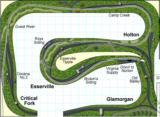 WM Track Plans WM Track Plans |
Photos | Models |
History
The rails in Maryland, Pennsylvania and West Virginia which eventually became the Western Maryland Railway were laid by more than 30 different railroads starting with the Baltimore, Carroll and Frederick Railroad in 1852. The WM’s mainline eventually extended from Baltimore, MD to Connellsville, PA where it connected with the Pennsylvania RR (PRR), Pittsburgh & West Virginia (P&WV), Pittsburgh & Lake Erie (P&LE), and Baltimore & Ohio (B&O).
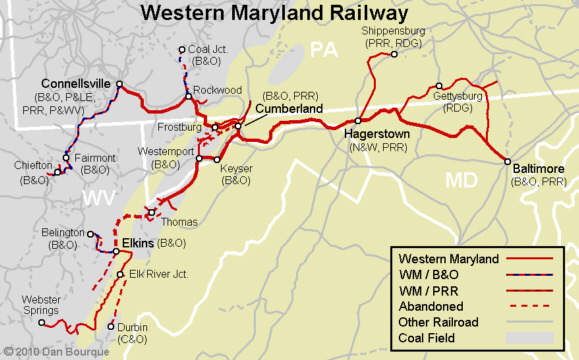 The WM was known as a coal railroad and served a number of coal branches, but its connections gave it access to a lot of bridge traffic as well. The WM was not a big railroad compared to its nearby competitors, the PRR and B&O, but its inclusion in the so-called “Alphabet Route” (NKP, W&LE, P&WV, Reading, Central of NJ and WM) allowed it to compete for traffic between the tidewater area and the midwest. The “Alpha Jets” ran over all of these lines with cooperation between the railroads speeding up service. Beginning around WWI, the B&O acquired 43% of WM stock, but its influence was held in check by court orders. Eventually, however, cooperation between the B&O and WM gradually increased as a matter of survival, and the Interstate Commerce Commission’s restrictions on B&O control were lifted. In a strange arrangement finalized in 1973, the C&O actually gained ownership of the WM, but the B&O took over operations as the companies joined forces under the Chessie System umbrella which still maintained separate identities for the B&O, C&O and WM. Finally, in 1987, the B&O was merged into the C&O which was merged into the newly formed CSX.
The WM was known as a coal railroad and served a number of coal branches, but its connections gave it access to a lot of bridge traffic as well. The WM was not a big railroad compared to its nearby competitors, the PRR and B&O, but its inclusion in the so-called “Alphabet Route” (NKP, W&LE, P&WV, Reading, Central of NJ and WM) allowed it to compete for traffic between the tidewater area and the midwest. The “Alpha Jets” ran over all of these lines with cooperation between the railroads speeding up service. Beginning around WWI, the B&O acquired 43% of WM stock, but its influence was held in check by court orders. Eventually, however, cooperation between the B&O and WM gradually increased as a matter of survival, and the Interstate Commerce Commission’s restrictions on B&O control were lifted. In a strange arrangement finalized in 1973, the C&O actually gained ownership of the WM, but the B&O took over operations as the companies joined forces under the Chessie System umbrella which still maintained separate identities for the B&O, C&O and WM. Finally, in 1987, the B&O was merged into the C&O which was merged into the newly formed CSX.
Coal Lines and Operations
The Western Maryland’s coal operations were concentrated in five areas. The easternmost were the lines north of Westernport, MD along Georges Creek. Between Elkins and the mainline at Cumberland, MD was the Thomas Subdivision, known for its coal branches (with mine runs out of Bayard, WV) and the 3% Black Fork Grade loaded coal trains faced moving east out of Elkins. After 1963, the Thomas Sub was also home of the branch to the Mount Storm power plant which consumed a large amount of railroad-fed coal, much of it originating from the nearby tipples at Bayard and the Georges Creek area. Two areas of WM coal were geographically separated from the WM, and both were reached via trackage rights over the B&O. The mines around Gray, PA (near Coal Jct.) were reached from the B&O connection at Rockwood, PA, and the productive branches near Fairmont, WV, served by mine runs out of the small WM yard at Chiefton, WV, were reached via 79 miles of trackage rights from the B&O connection at Connellsville.
The heart of the WM’s coal fields, though, was Elkins, WV. The large yard was home to numerous mine runs and locals and served several branches. The branch from Elkins to Belington was shared with the B&O allowing the B&O to abandon its redundant trackage in the area. The line from Elkins to Durbin, WV was not a coal branch, but it brought the only connection with the C&O and a small amount of bridge traffic. The major coal branch was the Elk River Branch extending from Elkins to Webster Springs, WV–coal country. Most of the line was the former Greenbriar, Cheat & Elk Railroad, a logging railroad with never-ending twists and turns (some requiring guardrails) and steep grades. The end of the line from Bergoo to Webster Springs, WV over the former West Virginia Midland (a 3-foot gauge line) was marked by third rail for a while. Coal from all these branches as well as the modest interchange traffic from the C&O were consolidated into trains at Elkins for the move over the Thomas Sub to the scales at Knobmount Yard in Cumberland. Pushers (often times 2 sets of 3-4 mid-train F-units) were added at Elkins for the push up Black Fork Grade before being cut off at Thomas.
Regardless of its origin, the vast majority of WM coal ended up in the classification yard at Knobmount, near Cumberland, MD where it was weighed and classfied. Most of the coal went to the WM’s coal piers at Port Covington, MD. The WM was somewhat unique among the eastern seaboard coal shippers in that it was able to gain revenue both ways for a while by loading its coal hoppers at the port with ore bound for steel mills in Pennsylvania and the midwest before returning them to the mines as empties. The coal pier at Port Covington was closed in 1973 when coal loading was transfered to the B&O’s pier at Curtis Bay.
Coal business in the diesel era was not as brisk for the WM as other Appalachian roads, but the WM’s many connections and commodities such as woodchips and pulpwood supplemented the traffic on the coal branches. One unique feature of the WM’s coal hopper fleet was the dominance of twin hoppers right into the Chessie era.
Related Products:
Source:
- The Western Maryland Railway – Fireballs and Black Diamonds by Roger Cook and Karl Zimmerman. Howell North Books.
 For related information, see the Chessie System and CSX pages
For related information, see the Chessie System and CSX pages




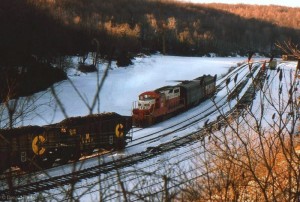
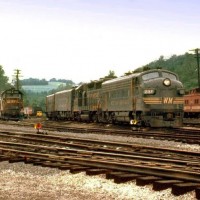 WM Prototype Photos
WM Prototype Photos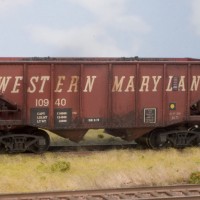 WM Model Photos
WM Model Photos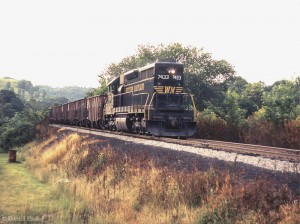
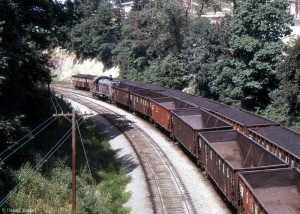
Pingback: WM Stony River Branch, WV track plan HO – Appalachian Railroad Modeling
Seems so long ago….I remember my brother running to the window to watch the trains move along the track….we lived in Thomas until 1943…moved to Philadelphia area…happy memories of life in WVa
seems so long so ..we lived in Thomas until 1943 ..moved to Phila Pa